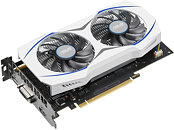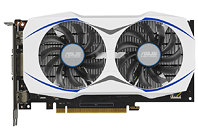Sunday, March 6th 2016

ASUS Intros GeForce GTX 950 Graphics Card with Slot-only Power
ASUS unveiled the a new GeForce GTX 950 graphics card that relies entirely on PCIe slot power. The GTX950-2G features a full-height, dual-slot design, with a simple monolithic heatsink cooling the GPU; and a pair of 70 mm spinners cooling it. The cooler shroud follows the same design theme as ASUS' mainline Z170 series motherboards, such as the Z170-A. The VRM design by ASUS keeps power draw of the GPU under 75W, and hence relies entirely on PCIe slot power. The GPU is clocked at 1026 MHz, with 1190 MHz GPU Boost, and 6.60 GHz (GDDR5-effective) memory. The company did not reveal pricing.



33 Comments on ASUS Intros GeForce GTX 950 Graphics Card with Slot-only Power
I'll be interested to see where this power saving magic comes from if someone does a detailed review. They say efficient VRMs in this one and the R7 360 50W card as well.
MINI-GTX950-2G